Intel Core i7-11700K Review: Blasting Off with Rocket Lake
by Dr. Ian Cutress on March 5, 2021 4:30 PM EST- Posted in
- CPUs
- Intel
- 14nm
- Xe-LP
- Rocket Lake
- Cypress Cove
- i7-11700K
CPU Tests: Office and Science
Our previous set of ‘office’ benchmarks have often been a mix of science and synthetics, so this time we wanted to keep our office section purely on real world performance.
Agisoft Photoscan 1.3.3: link
The concept of Photoscan is about translating many 2D images into a 3D model - so the more detailed the images, and the more you have, the better the final 3D model in both spatial accuracy and texturing accuracy. The algorithm has four stages, with some parts of the stages being single-threaded and others multi-threaded, along with some cache/memory dependency in there as well. For some of the more variable threaded workload, features such as Speed Shift and XFR will be able to take advantage of CPU stalls or downtime, giving sizeable speedups on newer microarchitectures.
For the update to version 1.3.3, the Agisoft software now supports command line operation. Agisoft provided us with a set of new images for this version of the test, and a python script to run it. We’ve modified the script slightly by changing some quality settings for the sake of the benchmark suite length, as well as adjusting how the final timing data is recorded. The python script dumps the results file in the format of our choosing. For our test we obtain the time for each stage of the benchmark, as well as the overall time.

There is a small performance gain here in the real world test across the three generations of Intel processors, however it is still a step away from AMD.
Application Opening: GIMP 2.10.18
First up is a test using a monstrous multi-layered xcf file to load GIMP. While the file is only a single ‘image’, it has so many high-quality layers embedded it was taking north of 15 seconds to open and to gain control on the mid-range notebook I was using at the time.
What we test here is the first run - normally on the first time a user loads the GIMP package from a fresh install, the system has to configure a few dozen files that remain optimized on subsequent opening. For our test we delete those configured optimized files in order to force a ‘fresh load’ each time the software in run. As it turns out, GIMP does optimizations for every CPU thread in the system, which requires that higher thread-count processors take a lot longer to run.
We measure the time taken from calling the software to be opened, and until the software hands itself back over to the OS for user control. The test is repeated for a minimum of ten minutes or at least 15 loops, whichever comes first, with the first three results discarded.
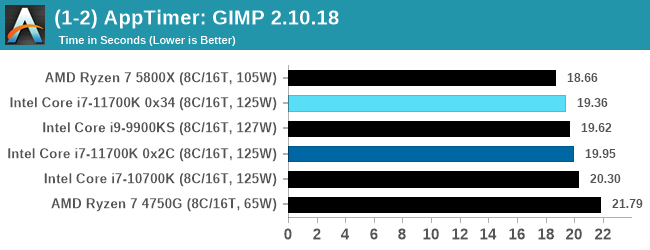
The app initialization test here favors single core performance, and AMD wins despite the lower single thread frequency. The 9900KS has a slight advantage, being a guaranteed 5.0 GHz, but none of the improved IPC from the Cypress Cove seems to come into play here.
Science
In this version of our test suite, all the science focused tests that aren’t ‘simulation’ work are now in our science section. This includes Brownian Motion, calculating digits of Pi, molecular dynamics, and for the first time, we’re trialing an artificial intelligence benchmark, both inference and training, that works under Windows using python and TensorFlow. Where possible these benchmarks have been optimized with the latest in vector instructions, except for the AI test – we were told that while it uses Intel’s Math Kernel Libraries, they’re optimized more for Linux than for Windows, and so it gives an interesting result when unoptimized software is used.
3D Particle Movement v2.1: Non-AVX and AVX2/AVX512
This is the latest version of this benchmark designed to simulate semi-optimized scientific algorithms taken directly from my doctorate thesis. This involves randomly moving particles in a 3D space using a set of algorithms that define random movement. Version 2.1 improves over 2.0 by passing the main particle structs by reference rather than by value, and decreasing the amount of double->float->double recasts the compiler was adding in.
The initial version of v2.1 is a custom C++ binary of my own code, and flags are in place to allow for multiple loops of the code with a custom benchmark length. By default this version runs six times and outputs the average score to the console, which we capture with a redirection operator that writes to file.
For v2.1, we also have a fully optimized AVX2/AVX512 version, which uses intrinsics to get the best performance out of the software. This was done by a former Intel AVX-512 engineer who now works elsewhere. According to Jim Keller, there are only a couple dozen or so people who understand how to extract the best performance out of a CPU, and this guy is one of them. To keep things honest, AMD also has a copy of the code, but has not proposed any changes.
The 3DPM test is set to output millions of movements per second, rather than time to complete a fixed number of movements.
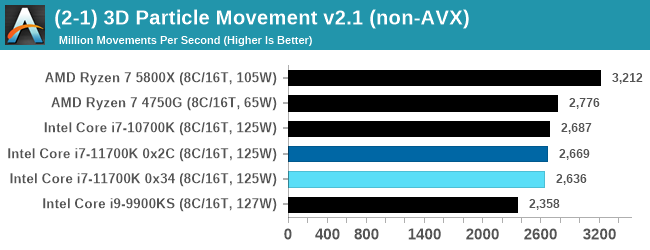
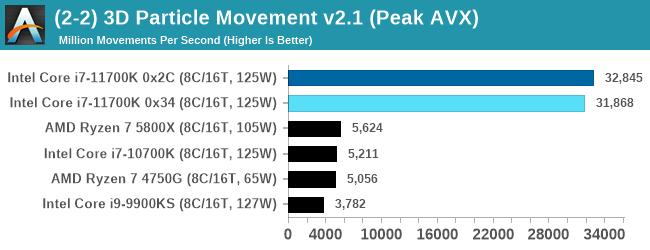
When AVX-512 comes to play, every-one else goes home. Easiest and clearest win for Intel.
y-Cruncher 0.78.9506: www.numberworld.org/y-cruncher
If you ask anyone what sort of computer holds the world record for calculating the most digits of pi, I can guarantee that a good portion of those answers might point to some colossus super computer built into a mountain by a super-villain. Fortunately nothing could be further from the truth – the computer with the record is a quad socket Ivy Bridge server with 300 TB of storage. The software that was run to get that was y-cruncher.
Built by Alex Yee over the last part of a decade and some more, y-Cruncher is the software of choice for calculating billions and trillions of digits of the most popular mathematical constants. The software has held the world record for Pi since August 2010, and has broken the record a total of 7 times since. It also holds records for e, the Golden Ratio, and others. According to Alex, the program runs around 500,000 lines of code, and he has multiple binaries each optimized for different families of processors, such as Zen, Ice Lake, Sky Lake, all the way back to Nehalem, using the latest SSE/AVX2/AVX512 instructions where they fit in, and then further optimized for how each core is built.
For our purposes, we’re calculating Pi, as it is more compute bound than memory bound. In ST and MT mode we calculate 250 million digits.
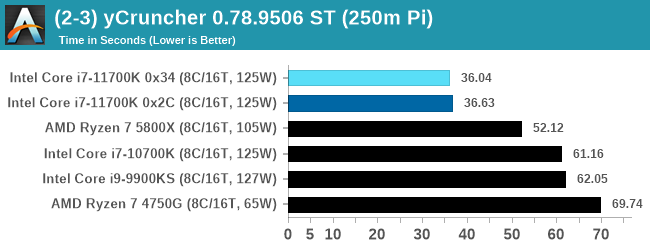
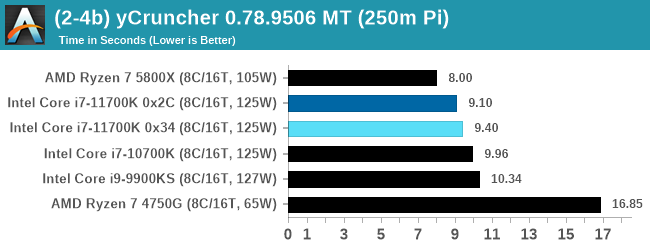
In ST mode, we are more dominated by the AVX-512 instructions, whereas in MT it becomes a mix of memory as well.
NAMD 2.13 (ApoA1): Molecular Dynamics
One of the popular science fields is modeling the dynamics of proteins. By looking at how the energy of active sites within a large protein structure over time, scientists behind the research can calculate required activation energies for potential interactions. This becomes very important in drug discovery. Molecular dynamics also plays a large role in protein folding, and in understanding what happens when proteins misfold, and what can be done to prevent it. Two of the most popular molecular dynamics packages in use today are NAMD and GROMACS.
NAMD, or Nanoscale Molecular Dynamics, has already been used in extensive Coronavirus research on the Frontier supercomputer. Typical simulations using the package are measured in how many nanoseconds per day can be calculated with the given hardware, and the ApoA1 protein (92,224 atoms) has been the standard model for molecular dynamics simulation.
Luckily the compute can home in on a typical ‘nanoseconds-per-day’ rate after only 60 seconds of simulation, however we stretch that out to 10 minutes to take a more sustained value, as by that time most turbo limits should be surpassed. The simulation itself works with 2 femtosecond timesteps. We use version 2.13 as this was the recommended version at the time of integrating this benchmark into our suite. The latest nightly builds we’re aware have started to enable support for AVX-512, however due to consistency in our benchmark suite, we are retaining with 2.13. Other software that we test with has AVX-512 acceleration.
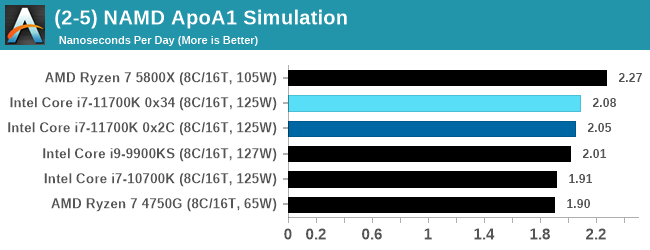
The 11700K shows some improvement over the previous generations of Intel, however it does sit much in the middle of the APU and the Zen 3.
AI Benchmark 0.1.2 using TensorFlow: Link
Finding an appropriate artificial intelligence benchmark for Windows has been a holy grail of mine for quite a while. The problem is that AI is such a fast moving, fast paced word that whatever I compute this quarter will no longer be relevant in the next, and one of the key metrics in this benchmarking suite is being able to keep data over a long period of time. We’ve had AI benchmarks on smartphones for a while, given that smartphones are a better target for AI workloads, but it also makes some sense that everything on PC is geared towards Linux as well.
Thankfully however, the good folks over at ETH Zurich in Switzerland have converted their smartphone AI benchmark into something that’s useable in Windows. It uses TensorFlow, and for our benchmark purposes we’ve locked our testing down to TensorFlow 2.10, AI Benchmark 0.1.2, while using Python 3.7.6.
The benchmark runs through 19 different networks including MobileNet-V2, ResNet-V2, VGG-19 Super-Res, NVIDIA-SPADE, PSPNet, DeepLab, Pixel-RNN, and GNMT-Translation. All the tests probe both the inference and the training at various input sizes and batch sizes, except the translation that only does inference. It measures the time taken to do a given amount of work, and spits out a value at the end.
There is one big caveat for all of this, however. Speaking with the folks over at ETH, they use Intel’s Math Kernel Libraries (MKL) for Windows, and they’re seeing some incredible drawbacks. I was told that MKL for Windows doesn’t play well with multiple threads, and as a result any Windows results are going to perform a lot worse than Linux results. On top of that, after a given number of threads (~16), MKL kind of gives up and performance drops of quite substantially.
So why test it at all? Firstly, because we need an AI benchmark, and a bad one is still better than not having one at all. Secondly, if MKL on Windows is the problem, then by publicizing the test, it might just put a boot somewhere for MKL to get fixed. To that end, we’ll stay with the benchmark as long as it remains feasible.
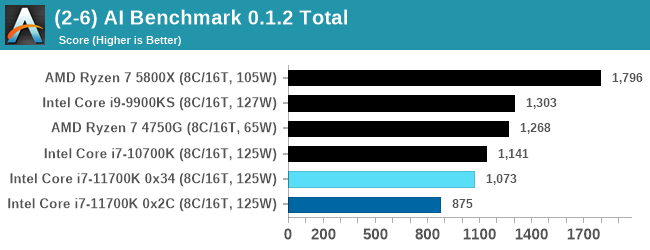
Every generation of Intel seems to regress with AI Benchmark, most likely due to MKL issues. I have previously identified the issue for Intel, however I have not heard of any progress to date.


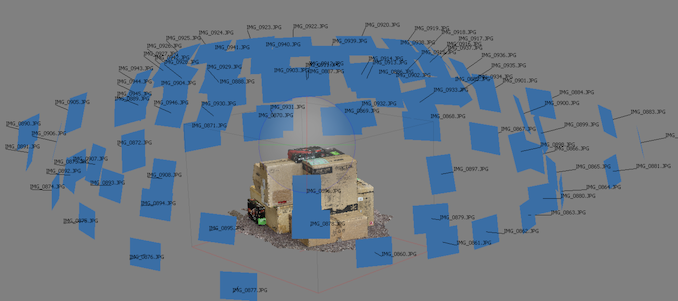

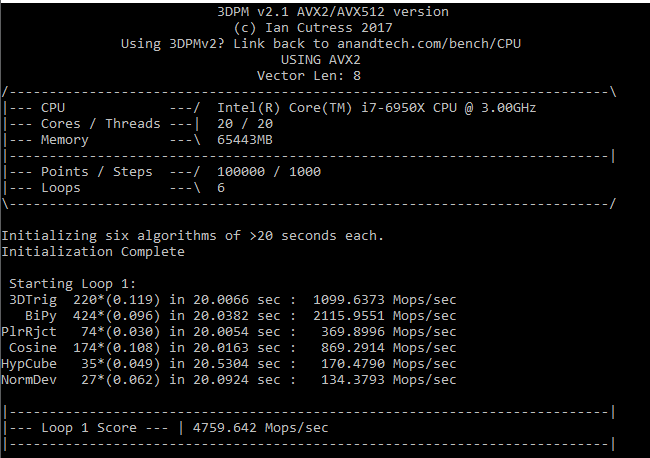
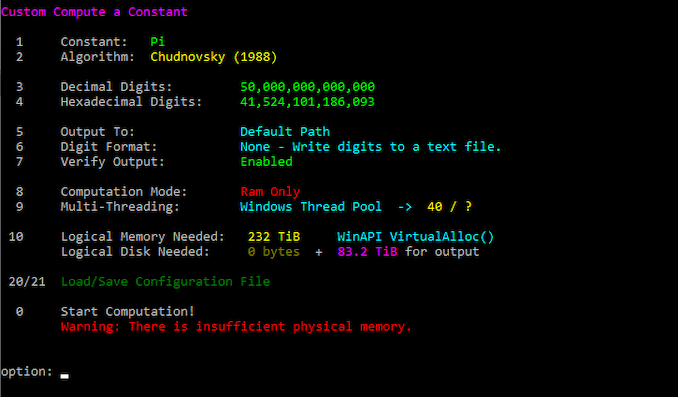
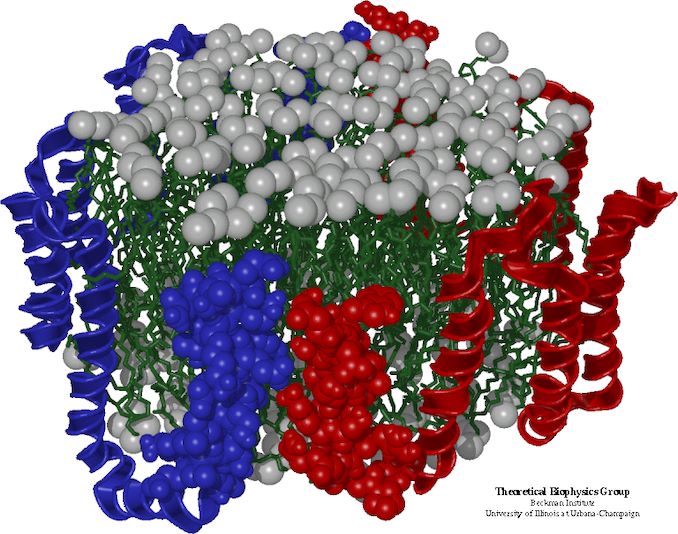









541 Comments
View All Comments
jacropolis - Sunday, March 7, 2021 - link
The 10700K is regularly $279 at Micro Center and isn't a bad buy for that price at all.Jadi - Sunday, March 7, 2021 - link
350 Dollar you want a 10700k and comparing it with a 5800X?Why?
The 5800X don t have a gpu, and the 10700ks was under 320 euros allways!
Now the 10700K not KS cost 316 euros!
Hot a 14nm Chip this is the advantage its only 60 c and a 5800X comes easy over 85 c and more.
More expansiv a 5800X cost 440 euros! A 5600X cost 350 euros, more then the 10700k!
Slower its a K CPU and can boost it up. When you OC the 5800X you have less fps.
Why you think it needs more power? Becouse the 40 sec boost? That is all and under AVX512 is it the only cpu that have it.
Games and other stuff its the same power, And 5800X dosen t stop at 105 Watt it goes like 118 watts. Thats are very close too 125 watts and more is only a limit time!
Spunjji - Monday, March 8, 2021 - link
@Jadi - that last bit of your post makes no sense. The 10700K and 11700K objectively require more power than the 5800X to do the same amount of work; the 5800X only hits 118 Watts under the same conditions that the other two approach 200 Watts. If you're comparing power draw during gaming, the 5800X uses less power than those two - roughly 25W less than the 10700K.Comparing temperatures is daft too. 85 degrees is way under the CPU's junction temperature, so it's not a problem to runa cPU at that temp - and it's objectively easier to keep an AMD CPU at that temperature than to keep an Intel chip at 60 degrees, because your cooler isn't dissipating as much heat.
TrueJessNarmo - Tuesday, March 9, 2021 - link
10700k is $320 on amazon and 9900k is $250 at microcenter.At this point 5900x is best for serious users and 9900k/10700k is for gamers. 5600x and 5800x are overpriced for what it is, but 5900x is a sweet deal at $550
rfxcasey - Wednesday, March 17, 2021 - link
I got my 10700K for 330 dollars new, I've seen them go for as low as 300.Makste - Saturday, March 6, 2021 - link
With gaming it's not the power consumption that's the problem here, it is the gaming performance in these benchmarks against comet lake obviously due to a higher latency.Zen 3's efforts have been put into perspective here, those engineers did quite a commendable job.
Bfree4me - Sunday, March 7, 2021 - link
Agreed! The Zen architecture is top shelf. But it took far too long. My last AMD Cpu was an Athlon 1800 because at that time AMD was the value leader and Intel was the performance king for a price. At the time came where I needed performance over value.So I have been Intel since then. Time to start looking towards Zen 🤔
Timoo - Monday, March 8, 2021 - link
If I may be so free: "Took way too long": I agree.I just keep in mind that it took them way too long, because Intel managed to create some very shady deals with retailers, effectively pushing AMD out of the market and to the brink of bankruptcy. So, for years AMD has been struggling to stay alive.
Agreed, buying ATi didn't help either. But without those shady deals they might have pulled it off. From 2006 to -say- 2015 AMD was only struggling to stay alive. I believe they had some huge cash injection at the time, together with getting one of the best CPU designers in the world (what's his name?) back in the house.
So, in my opinion, AMD is forgiven for their 10-year "heart-attack".
GeoffreyA - Monday, March 8, 2021 - link
I also believe it was because the K10, or Phenom, while being faster than the Athlon 64, was not aggressive enough. It had already been designed before Core 2 Duo came out, and by then, Intel was ahead of them. Who knows, they might have narrowed the gap if they had persisted with the K10 design, widening everything till it matched/surpassed Nehalem, but they shot too far, going for Bulldozer, which was supposed to turn the tables round but sank them further in the ditch.TheinsanegamerN - Monday, March 8, 2021 - link
And yet AMD was having trouble supplying enough chips to the limited market they did have. Much like today. OEMs are not going to sign up with a company that cant consistently supply CPUs.Dont forget the billiosn they poured into making GF and pissing off TSMC in the process.